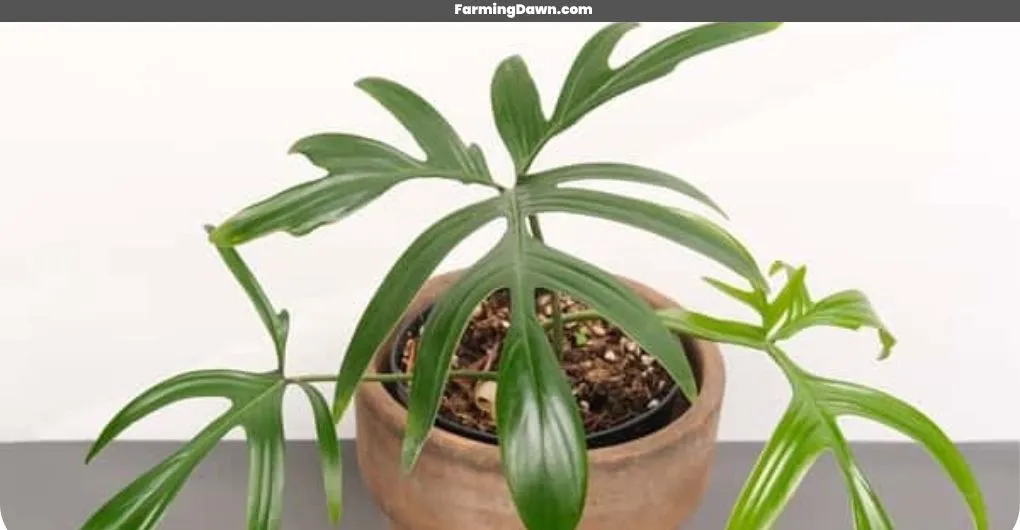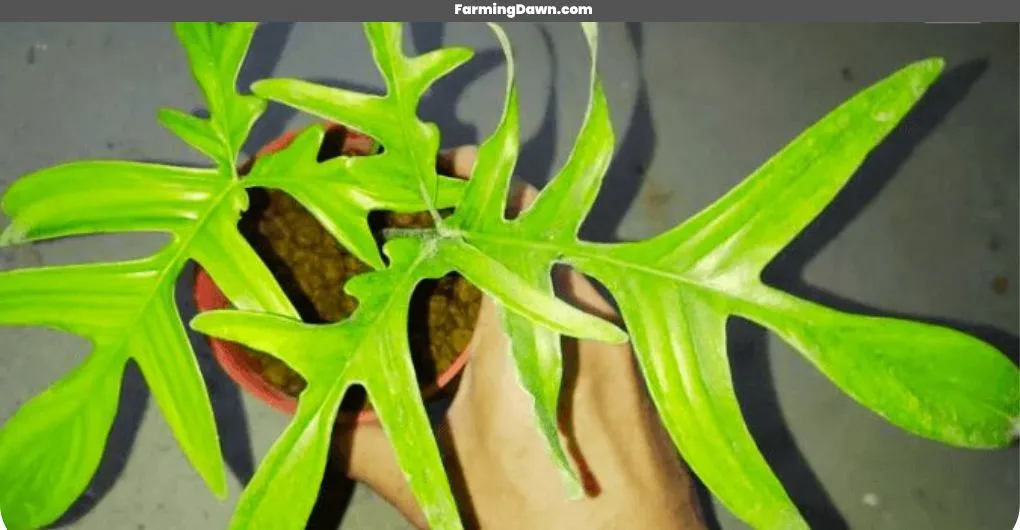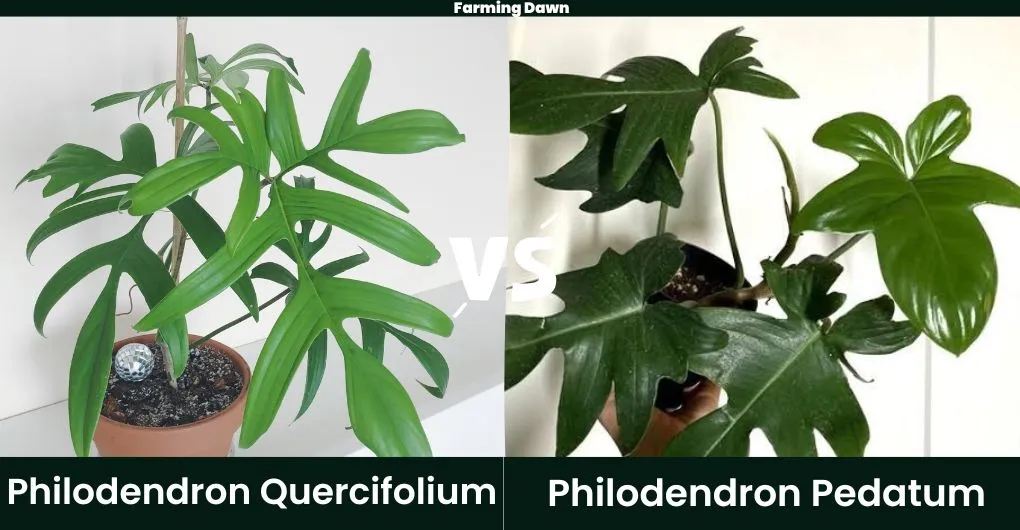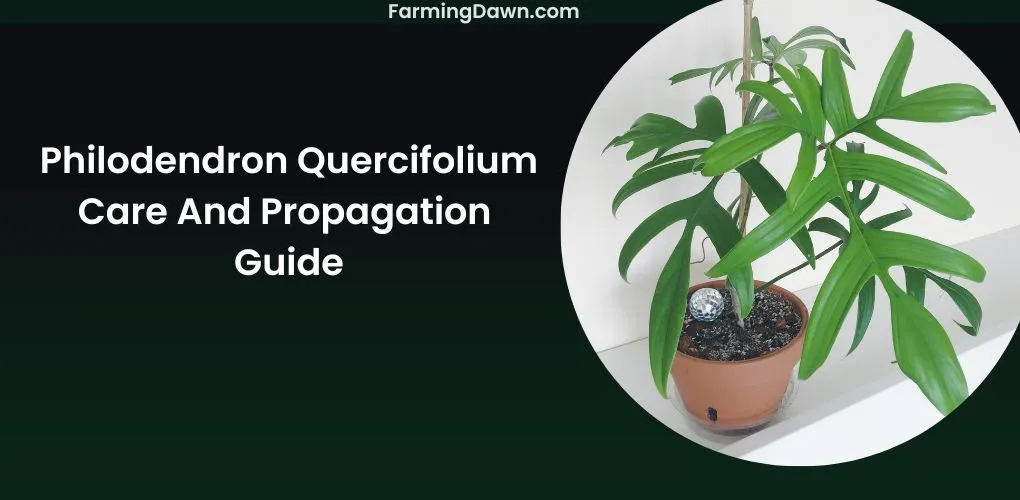The Philodendron Quercifolium is a great addition to any home or office that needs some life, warmth, and color! It’s not only visually stunning but it has quite a few characteristics that make it unique from other varieties of philodendrons. In this article, we’ll look at an overview of the Philodendron Quercifolium, its characteristics, care instructions, and how to propagate it if desired. So let’s get started!
Philodendron Quercifolium Overview
Philodendron quercifolium is an amazing and unique houseplant with a striking leaf shape. Its large, lobed leaves are so distinct that they look like oak tree leaves, hence its name. I love the way it adds texture to any room, it looks just as good in modern or traditional decor!
Related: How to care for Philodendron squamiferum?
Here take a quick overview of this beautiful plant!
| Scientific name | Philodendron spp. |
| Common names | P. Pedatum, Oak Leaf Philodendron |
| Origin | Columbia, Brazil, Guyana, Bolivia, Ecuador, Surinam, and Venezuela are all in tropical South America. |
| Family | Araceae |
| Plant type | hemiephiphytic appressed climber |
| Size | Over 1 foot long and 8 inches wide |
| Temperature | 50-80F |
| Leaf Color | Narrow green |
| Flower Color | dark pink to reddish flowers. |
How To Care For Philodendron Quercifolium?

Light Requirements
I’m sure you’re wondering what kind of light the Philodendron quercifolium needs in order to thrive. Well, I wouldn’t keep you in suspense any longer. This plant is best kept in bright, indirect sunlight for most of its life cycle. It can also tolerate some periods of shade throughout the day as well.
Ideally, it should receive a few hours of direct morning sun and then be moved to an area that receives filtered or shaded light for the remainder of the day. You’ll want to ensure your P. quercifolium doesn’t receive too much direct sun as this may scorch its leaves and damage them beyond repair.
The key here is balance, not too much sunshine but not too little either! Make sure your plant gets just enough so that it remains healthy and vigorous while avoiding exposure to excessive amounts of UV rays that could harm its delicate foliage.
Learn more: How to care for Hoya Linearis?
Temperature & Humidity
Now that you know the light requirements for Philodendron quercifolium, let’s talk about temperature and humidity. This plant loves to be kept in a warm environment, temperatures between 55°F-85°F (12°C-29°C) are ideal.
It also appreciates higher levels of humidity, so keep it away from drafty windows or air conditioning units if possible. If your environment is on the drier side, use a pebble tray or mist regularly to raise the humidity around your plant. Here’s a quick table summarizing what we’ve talked about:
|
Temperature |
Humidity |
| 65°F-85°F (12°C-29°C) | High/Regular Mistings |
I’m sure with these tips in mind, you can easily create an optimal home for your P. quercifolium!
Watering & Fertilizing
Watering and fertilizing your philodendron quercifolium is a must for keeping it healthy and happy. In the olden days, people used to water their plants with rainwater collected in barrels, but modern gardeners can use tap water without issues too! Just make sure that you let it sit out for at least 24 hours so any chlorine or other chemicals have time to dissipate.
When watering, saturate the soil until some of it runs through the drainage holes into a tray below; then remove this excess after 10 minutes. To feed your plant, apply liquid fertilizer every one or two weeks during the spring and summer months. Doing this will help keep your philodendron looking lush and vibrant!
For best results, always dilute the concentration according to package instructions as over-fertilizing can be harmful to leaves and roots. So there you have it, with just these few simple steps, you’ll be well on your way towards growing a beautiful P. quercifolium in no time!
Pests & Diseases
When it comes to pests and diseases, Philodendron quercifolium is relatively resistant. That being said, there are still a few issues that can arise if the plant isn’t given proper care. The most common problems include mealybugs, aphids, scale insects, spider mites, and root rot.
|
Name of Pest/Disease |
Description |
Prevention/Treatment |
| Mealybugs | Soft-bodied white insects found on leaves or stem; secrete wax-like substance. | Regularly inspect plants for signs of infestation. Use an organic insecticidal soap or neem oil solution to treat any existing bugs. Prune off heavily infested areas. |
| Aphids | Small green, black, or yellowish insects that feed on sap from young shoots and leave behind sticky residue known as honeydew. | Remove any affected parts with cotton swabs dipped in rubbing alcohol or a soapy water solution
(1 teaspoon of dishwashing liquid per quart of lukewarm water). Treat remaining plants with horticultural oils or sprays containing pyrethrin. |
| Scale Insects | Hard shells cover small brown insects; feeds by sucking sap from stems and leaves leaving them wilted and discolored. | Physically remove any scales manually using tweezers and dispose away from other plants. Treat remaining plants with horticultural oils or insecticides containing pyrethrins & piperonyl butoxide (PBO) combination products such as Pyrenone® 25–5 EC. |
| Spider Mites | Tiny red spiders living on the undersides of foliage; causes stippling of the leaf surface & webbing under the leaves. | Use a magnifying glass to spot webs these mites create between veins underneath the leaves & look out for tiny specks moving around quickly when disturbed.
If you find any mite activity, spray a strong jet of water directly onto the underside of infected leaves to dislodge them & repeat every 3 days until the problem disappears. |
| Root Rot | A fungal disease caused by overwatering leading to softening & decay at roots’ tips. | Make sure soil drains well after each watering session – allow the top inch or two to dry before rewatering again; avoid overfertilizing. |
To prevent all these pests and diseases, make sure your Philodendron quercifolium is getting enough sunlight and air circulation while keeping its environment clean from debris like dead leaves and dust particles building up on its foliage surfaces. Inspect your plant regularly for signs of pest invasion as soon as possible since early detection will help stop further spread throughout your entire collection!
Repotting & Pruning
Repotting and pruning your philodendron quercifolium is a necessary part of its care. It’s easy to do, but there are some things you need to keep in mind. First off, repotting should be done in the early spring when the plant is beginning to become active again after winter dormancy. Make sure you use well-draining soil that contains plenty of organic matter so that it holds moisture.
Pruning can also be beneficial for this type of philodendron as long as it is done correctly. Cut back any spindly or leggy stems with sharp scissors and make sure not to cut into the main stem of the plant itself. Both repotting and pruning will help promote healthier growth in your P. quercifolium, ensuring it looks its best all year round.
How To Propagate Philodendron Quercifolium?
Knowing how to propagate P. Quercifolium is just as essential for growth as caring for the plant. Here I will discuss two different methods of propagation that I tried in my garden and achieved fruitful results:
- Propagation From Stem Cuttings
- Propagation From Root Division
Let’s discuss these points one by one.
See more: How to propagate Philodendron Burle Marx?

Propagation From Stem Cuttings
Propagating your plant from stem cuttings is a great way to get its population growth, and you don’t even need any fancy equipment! All you really need is a sharp pair of scissors or pruning shears, some well-draining soil mix, and rooting hormone (optional).
To start the process off, take a few healthy stems that are at least 4 inches long with several nodes along them. Then snip each cutting just below a node so that it can draw nutrients from the leaves instead of relying solely on its root system for energy.
Dip the base of these cuttings in powdered rooting hormone if desired before planting into moist but not soggy soil. Place them somewhere warm out of direct sunlight and mist regularly until they begin to sprout roots. In no time, you’ll have fresh new plants ready to be transplanted!
Propagation From Root Division
Propagating philodendron quercifolium is a snap! As easy as pie, all you have to do is take a big root ball of the plant and divide it into two or more sections. This will give you multiple plants that look almost identical to their parent, absolutely amazing! You can even get creative with this process and make your own unique patterned leaves.
It’s like magic; watch your new babies grow in no time flat! Plus, if done correctly, propagating by root division won’t harm the mother plant in any way, a win-win situation for everyone involved!
Philodendron Quercifolium Vs Philodendron Pedatum
For quite some time, I’ve been doing some research on quercifolium vs pedatum. Both are tropical plants and share the same family and almost similar shapes and habitats. Let’s discuss their similarities and differences.

Morphology
Philodendron quercifolium and pedatum are two species of philodendrons that have some similarities in morphology. They both form large, deeply-lobed leaves with a leathery texture and ribbed veins. The leaf shape is also almost identical between the two plants, except for the fact that P. quercifolium’s leaves tend to be slightly larger than those of P. pedatum.
P. quercifolium has an upright growth habit, while P. pedatum tends to spread horizontally forming mats or clumps over time, making it a great choice for ground cover!
Both these beautiful houseplants require similar care and will do best in bright indirect light with regular watering and fertilizing during their growing season. So whether you choose one or the other, you’re sure to get a stunning addition to your home!
Habitat
When it comes to the habitats of Philodendron quercifolium and pedatum, both species prefer humid tropical climates with plenty of indirect sunlight, but P. quercifolium is more tolerant of drier conditions than its counterpart.
Both plants need soil that drains quickly and is happiest when placed in a warm spot away from drafts or air conditioning vents. Keeping your philodendrons happy gives you an excuse to show off their gorgeous foliage and make them part of your home’s décor while giving you a sense of belonging.
Cultivation
Now that you know where to put your philodendrons, it’s time to talk about how to make sure they’re happy and healthy. For both species of philodendron, regular watering is key, but don’t overdo it! Letting the soil dry out between waterings will help ensure the roots are getting enough air.
And fertilizing once a month during the spring through fall can provide an extra boost for your plants. And if you want more lush growth, misting your plants with room-temperature water every few days should do the trick. And here we sum up our comparison of P. quercifolium and pedatum.
Frequently Asked Questions
What is the common name for philodendron Quercifolium?
P. Quercifolium is more commonly known as Oakleaf Philodendron. It is a type of climbing plant that belongs to the Araceae family, which is native to Central and South America.
Is Philodendron pedatum var Quercifolium?
The botanical name Philodendron pedatum var. Quercifolium is incorrect. A distinct species of Philodendron called Philodendron pedatum has deeply lobed, fern-like leaves. Philodendron Quercifolium, on the other hand, is a cultivar or variety of Philodendrons that is distinguished by its oak leaf-shaped leaves. As a result, the botanical name Philodendron pedatum var. Quercifolium is invalid.
What is philodendron pedatum glad hands aka quercifolium?
P. pedatum and P. Quercifolium are two distinct species of Philodendron plants that have different leaf shapes and growth habits. Philodendron pedatum has deeply lobed, fern-like leaves, while Philodendron Quercifolium has oak leaf-shaped leaves. Glad hands is a common name for a particular cultivar or variety of Philodendron.
What is the most beautiful rare philodendron?
There are many rare and unique species of Philodendron plants that are highly sought after by collectors and enthusiasts. Here are a few examples:
- Philodendron Pink Princess.
- Philodendron Spiritus Sancti.
- Philodendron gloriosum.
- Philodendron Joepii.
- Philodendron Cobra.
Final Verdict: Philodendron Quercifolium Care
The quercifolium is truly a marvel of nature! With its unique foliage and resilient characteristics, it has quickly become one of my favorite houseplants. I just can’t get enough of this plant’s beauty as well as the ease with which you can care for it.
From light requirements to watering and fertilizing needs, this wonderful specimen really takes all the fuss out of being a good gardener. And if that weren’t enough, propagation through root division makes it easy to share with your friends and family, so everyone can experience the sheer joy that is owning a philodendron quercifolium!
Each plant has different care requirements and propagation methods. Read my other articles to learn more:






